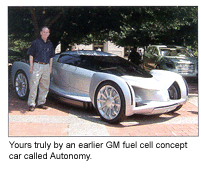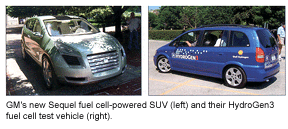I’ve seen the future and it’s a gas – hydrogen gas, that is. At a recent General Motors press conference at Northwestern University in Evanston, IL, Larry Burns, vice president of GM Research & Development, described the future of automotive technology.
 Today, there are about 750 million cars and trucks on the face of this planet. Yet only about 12% of the world’s population can afford to own a vehicle. As economies in China, India, Mexico and other countries expand, vehicle ownership will become possible for millions of people who previously couldn’t afford a vehicle. By 2020, GM conservatively predicts the world vehicle population will exceed 1.1 billion cars and trucks!
Today, there are about 750 million cars and trucks on the face of this planet. Yet only about 12% of the world’s population can afford to own a vehicle. As economies in China, India, Mexico and other countries expand, vehicle ownership will become possible for millions of people who previously couldn’t afford a vehicle. By 2020, GM conservatively predicts the world vehicle population will exceed 1.1 billion cars and trucks!
These numbers make it obvious that we’re headed for some serious problems unless we somehow reduce our dependence on petroleum. Today’s oil prices (which are around $60 a barrel) and gasoline prices ($2.30 at the pump) will seem cheap in comparison to what we will likely be paying in the not too distant future as worldwide demand outpaces the worldwide supply of oil.
According to the latest oil industry estimates, world petroleum reserves are thought to be around 3 trillion barrels. We have already used up about a quarter of the total, and are currently consuming oil at the rate of 75 million barrels per day. Two-thirds of the oil we import is used for transportation in this country. If the world vehicle population continues to expand at its current rate, we’re headed for trouble. The world simply can’t supply enough petroleum to support this kind of growth and usage.
So what’s the answer? Ration cars? Tell the rest of the world they can’t have what we have? GM and most of the other auto makers think the best solution is to shift our dependence from petroleum to a different energy source – namely hydrogen.
 Hydrogen is the simplest of all known elements, and the most abundant element in the universe. Water, which covers two-thirds of our planet, is two parts hydrogen and one part oxygen. Passing an electric current through water (a process called “electrolysis”) can split water molecules apart freeing the hydrogen from the oxygen. The energy for electrolysis can be generated by solar cells, nuclear plants, wind generators, hydroelectric dams, geothermal generators, wave generators or even conventional fossil fuel burning power plants. Hydrogen gas also can be made from biomass or even garbage. The potential supply of hydrogen would seem to be almost limitless.
Hydrogen is the simplest of all known elements, and the most abundant element in the universe. Water, which covers two-thirds of our planet, is two parts hydrogen and one part oxygen. Passing an electric current through water (a process called “electrolysis”) can split water molecules apart freeing the hydrogen from the oxygen. The energy for electrolysis can be generated by solar cells, nuclear plants, wind generators, hydroelectric dams, geothermal generators, wave generators or even conventional fossil fuel burning power plants. Hydrogen gas also can be made from biomass or even garbage. The potential supply of hydrogen would seem to be almost limitless.
Hydrogen is also a clean-burning fuel that generates no carbon monoxide, no hydrocarbons and no soot – only water vapor. It can also be burned in internal combustion engines, but its best use is in fuel cells – and that’s the future of automotive propulsion, says Burns.
A fuel cell is a relatively simple device that combines hydrogen and oxygen to create electricity. The electric current can then be used to turn electric motors to drive a vehicle. Fuel cells were invented as a power source for space capsules back in the 1960s, and researchers have been playing with them ever since in an effort to improve their efficiency and performance, and reduce their cost.
It seems that the pay-off is close at hand. GM’s latest hydrogen fuel cell-powered car (HydroGen3) is seven times more efficient than GM’s last hydrogen-powered test car, which was built six years ago. Burns says GM should have a production-ready hydrogen-powered car by 2010. In fact, GM’s latest concept car, called “Sequel,” is a five-passenger crossover SUV that uses both a hydrogen fuel cell and lithium ion battery for combined power. The Sequel that was on display at the press conference appears to be a preview of what may be GM’s first fuel cell-powered production vehicle for the U.S. market.
The main issues now, said Burns, are the cost and availability of hydrogen. GM estimates it will cost about $10 to $15 billion to add hydrogen refueling capabilities to 11,700 service stations across the U.S. And if hydrogen is manufactured from natural gas at today’s prices, it would cost about 1.3 times as much to power a vehicle with hydrogen compared to gasoline. But those numbers may soon change.
Hydrogen is currently around $4 per kilogram. If a hydrogen-powered car holds 8 kilograms of hydrogen in its tanks (enough to give it an estimated driving range of 300 miles), it would cost $32 to fill up. Compare that to what it currently costs to fill up a big fuel-thirsty SUV – say $60 to $70. Seems to me hydrogen is already a bargain.
I test drove the HydroGen3 fuel cell research vehicle, and found it to be remarkably unremarkable. That’s actually a compliment because it drove pretty much like any other small car. Except for a little electric motor whine, the test drive was relatively quiet and uneventful.
The neat thing about this exotic technology is that it is essentially invisible to the driver. If the car wasn’t plastered with decals and didn’t contain engineering instrumentation, I’d have no way of knowing I was driving something that is radically different from what I’ve been driving all my life. The technology works and works well.
Hydrogen, however, is a much different kind of fuel than gasoline or diesel. It is a lightweight gas, not a liquid, and contains far less energy than gasoline. So hydrogen must be stored under extremely high pressure (up to 10,000 psi!), or liquefied at extremely low temperature (-423













